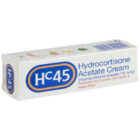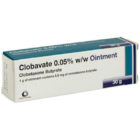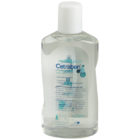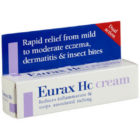
Hydrocortisone 1% Cream & Ointment
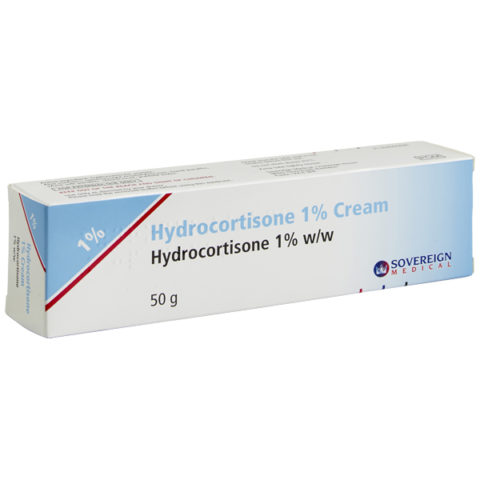
* The brand supplied may vary. Please contact us if you require a specific brand.
- Includes free private prescription
- Free delivery over £40
- 100% UK-based pharmacy
- Free advice and support
- We're rated 4.9 out of 5
About Hydrocortisone 1% Cream & Ointment
Struggling with an unpleasant dry skin condition? Looking for a powerful eczema treatment cream or seeking relief from an insect sting?
Hydrocortisone 1% ointment and cream are effective in the alleviation of inflammation, itching, and redness of the skin caused by a variety of skin conditions.
Hydrocortisone 1% Cream and Ointment are:
- Clinically proven to treat dry skin conditions such as eczema or dermatitis. It’s also perfect for use on a variety of other dry skin conditions.
- Designed to soothe itchiness and inflammation for up to 12 hours.
- Easy to apply. Like other eczema treatment creams, just rub Hydrocortisone directly onto the affected area.
- Available to buy online today from The Independent Pharmacy, for adults over the age of 18 years — simply complete a free health consultation for review by our UK-based medical team.
| Type of medicine | Steroid |
| Works by | Reducing the inflammation in the skin |
| Effective within | 1 day |
| Pack size | 50g tube |
| Strength | 1% |
| Common side effects | Contact dermatitis - localised rash or irritated skin. |
| Manufacturer | Sovereign Medical, Pinewood Healthcare and others |
| Generic | Yes |
| Use with alcohol | No known issues |
We stock 2 different variants of Hydrocortisone 1% Cream & Ointment
Hydrocortisone 1% Information
What is Hydrocortisone Cream/Ointment and what is it used for?
Hydrocortisone 1% Cream/Ointment treats inflammation from skin conditions such as allergic reactions, eczema and psoriasis. It is a topical steroid that works to reduce chemicals in the body that cause swelling.
Topical steroids, such as Hydrocortisone, play an important role in eczema treatment. When eczema flares up, applying a steroid-containing medication will reduce inflammation, ease soreness and reduce itching.
Hydrocortisone 1% Cream/Ointment is a generic cream that treats certain skin conditions, such as eczema, dermatitis, & psoriasis. The cream and ointment are corticosteroids and should be applied to affected areas once or twice a day, usually for no longer than one week.
How long can I use Hydrocortisone Cream for?
In most cases, a seven-day course of hydrocortisone cream for eczema treatment should be enough to relieve your symptoms and those of most other minor inflammatory skin conditions. Do not use Hydrocortisone for any more than seven days unless instructed to by your doctor.
It’s not recommended to take Hydrocortisone more than twice a day. If this isn’t enough to control your symptoms, seek the advice of your GP.
How does Hydrocortisone work?
Hydrocortisone is a corticosteroid. Classed as a mild steroid, it can be used to step down your treatment if stronger steroid preparations are no longer necessary.
Topical corticosteroids have been used for over 50 years to treat various inflammatory skin conditions. They remain one of the most effective treatments, and if used properly, can control symptoms and restore patients’ quality of life.
Steroids are produced naturally by the body to regulate growth and immune function. There are many kinds of steroids, including anabolic steroids like testosterone and corticosteroids such as cortisol, which are produced by the adrenal glands.
Corticosteroids are very effective at controlling inflammation since they temporarily alter the function of a number of cells and chemicals in the skin.
What if I forget to apply Hydrocortisone?
There is no need to worry if you forget to use a hydrocortisone skin treatment. Take it as soon as you remember, unless your next dose is within a few hours. If this is the case, skip the missed dose and resume your regular schedule.
What is eczema?
Eczema is a skin ailment indicated by redness, dryness, flaky, scaly skin and irritation. Sufferers often scratch, causing skin breaks and bleeding. More serious instances may result in pus-filled blisters and even infected skin.
Most eczema symptoms manifest around the elbows and knees, on the scalp, and on the hands and feet. However, eczema can appear anywhere on your skin, so you may experience it on other areas of your body.
Eczema & dermatitis can affect anyone of any age. Most cases appear before the age of 35 and are chronic, with periods of activity and remission. Common triggers include:
- Stress
- Skin injury
- Excess alcohol consumption
- Smoking
- Certain medications
- Hormonal fluctuations
- Insect bite reactions*
*Nummular eczema is commonly triggered by insect bites.
Eczema can also be triggered by skin irritants. This type of eczema is known as irritant dermatitis and it can lead infants to develop nappy rash. Common triggers include:
- Antibacterials and antiseptics
- Toiletries and cosmetics
- Detergents and soaps
- Disinfectants
- Oils
Eczema is one of the most common skin issues, affecting around 10% of adults and 20% of children in the UK. Some of the other common skin issues people experience include cold sores, acne and various types of psoriasis — such as widespread plaque psoriasis and generalised pustular psoriasis.
Currently, eczema has no cure. Eczema treatment aims to reduce the severity of symptoms. Topical corticosteroids are the go-to option for mild to moderate cases.
Non-prescription alternatives for eczema & dermatitis
Prescription medications such as Hydrocortisone 1% and Hydrocortisone Cream can be highly effective at tackling the symptoms of eczema, such as broken or infected skin.
But prescription medications aren’t the only way of treating eczema. These are some of the over-the-counter treatments you can use to tackle eczema:
- Moisturisers and emollients - Diprobase and Cetraben
- Bath and Shower Gels - Dermol 200 and Cetraben Bath Additive
- Cream and ointment - Cetraben Cream & Ointment
- Cotton Gloves (to keep from scratching)
- Antihistamine tablets (to ease the itching) - Loratadine and Cetirizine
Sources
- Hydrocortisone Cream, Patient Information Leaflet: https://www.medicines.org.uk/e...
- Hydrocortisone Ointment, Patient Information Leaflet: https://www.medicines.org.uk/e...
- https://www.nhs.uk/conditions/...
How to apply Hydrocortisone 1%
Hydrocortisone 1% Cream/Ointment should be applied to the affected areas in a thin layer, once or twice daily.
- Be sure to wash your hands after applying the treatment, unless the symptoms are on your hands.
- After it has been absorbed, moisturising skin creams (such as Diprobase or Cetraben) can be applied, if necessary.
- When symptoms begin to improve, start using Hydrocortisone less often. You should not use Hydrocortisone for more than 10 days consecutively and see your doctor if there is no improvement within the 10-day period.
You don’t need to worry if you find you have missed a dose of your cream or ointment. If this happens, then just apply the cream as soon as you can (unless your next dose is a few hours away) and then return to your previous routine of systemic administration.
Hydrocortisone 1% Cream & Ointment ingredients
Active ingredients: Hydrocortisone 1%.
The inactive ingredients in Hydrocortisone 1% Cream are: Chlorocresol, cetomacrogol, cetostearyl alcohol and paraffin.
The inactive ingredients in Hydrocortisone 1% Ointment are: Wool Fat, liquid paraffin, white soft paraffin.
Hydrocortisone 1% Cream & Ointment side effects
Hydrocortisone is usually safe and does not have any side effects when taken in short courses (less than four weeks). However, if used for long periods, the following rare side effects may occur:
- Thinning of the skin
- Permanent stretch marks
- Allergic contact dermatitis (localized rash or irritated skin), acne, rosacea, or hair growth at the site of application
To minimise the risk of these side effects, apply the cream thinly, and only on the affected area of skin. As Hydrocortisone creams and ointments contain paraffin, they can also pose a fire risk if absorbed into clothes or furniture. If you’ve recently applied Hydrocortisone, keep away from naked flames.
If you are concerned about these effects, or if the product affects you in a different way, stop using it and consult your doctor or pharmacist.
Hydrocortisone 1% warnings
Read the following warnings carefully to ensure you are selecting an appropriate product.
Do not use Hydrocortisone 1% Cream/Ointment if you:
- Are allergic to any of its ingredients.
- Suffer from skin conditions caused by infections, which are not being treated with antibiotics.
- Have scabies mite.
- Have rosacea or dermatitis around the mouth area.
Check with your doctor/pharmacist before using Hydrocortisone 1% Cream if:
- You are applying the cream to the face and around the eyes.
- You have a skin infection and the condition appears to be getting worse despite prescribed antibiotics. Stop using the cream and contact your doctor.
- You have psoriasis.
This cream contains cetostearyl alcohol which may cause local skin reactions such as contact dermatitis. It also contains chlorocresol which may cause allergic reactions in some people.
Please read all packaging and the Product Information Leaflet before taking any new medications. Inform your doctor or the appropriate healthcare professionals of any medications you are taking or intend to take.
Hydrocortisone 1% Cream & Ointment reviews
Hydrocortisone 1% Cream & Ointment FAQs
It is used to treat itching, redness, and swelling associated with conditions of the skin.
It is a topical corticosteroid that reduces skin inflammation.
There are situations in which Hydrocortisone 1% Cream should be used cautiously or not at all. If you have a skin infection and have reacted to other steroid preparations before, Hydrocortisone 1% is not recommended. Don’t use this cream on the face or around the anal or genital areas unless instructed to do so by your doctor. Don’t use this treatment if you have an allergy to any of its active or inactive ingredients.
If you are taking any other medications, including other creams or eczema treatments – inform our online doctor. Mention whether they were prescribed by your doctor or purchased over-the-counter.
You should not use Hydrocortisone 1% Cream if you are pregnant, think you might be pregnant, are breastfeeding or planning to breastfeed, unless your doctor has advised it.
If Hydrocortisone 1% cream doesn’t work for you, tell your doctor as you may need a different treatment.
In rare cases, topical corticosteroids can cause lightening or darkening of the skin, which resolves when the treatment stops. Skin discoloration is more likely to occur from the eczema itself, because skin inflammation can increase or decrease the amount of tan pigment in the skin. Skin discoloration from eczema typically resolves over time, but may take several months. In cases of severe and long-lasting inflammation, some pigmentation changes can be permanent.
If used for long periods, topical corticosteroids can occasionally cause a temporary, mild increase in fine hair growth in the treated areas. Frequent scratching can also cause a temporary, mild increase in hair growth.
There is no evidence to suggest that topical corticosteroids prolong eczema. An allergic reaction to the steroid may make eczema symptoms appear worse or prolonged. Any worsening or static symptoms should be evaluated for allergic contact dermatitis.
While proper bathing and moisturizing are important for the management of chronic eczema, they are only a first-line defence. Once moderate to severe eczema becomes inflamed, additional anti-inflammatory medication is necessary to control the disease. Treatments include topical corticosteroids, ultraviolet light therapy, topical calcsineurin inhibitors (TCIs such as Elidel or Protopic), or systemic medications.
While only a thin layer of medication is needed, it is important to apply enough to cover all the red areas. Use the fingertip rule: squeeze a line of the topical corticosteroid onto your index finger, from the fingertip to the first finger crease. This amount represents a fingertip unit and should be enough to cover an area of skin the size of two flat adult hands.
While only a thin layer of medication is needed, it is important to apply enough to cover all the red areas. Use the fingertip rule: squeeze a line of the topical corticosteroid onto your index finger, from the fingertip to the first finger crease. This amount represents a fingertip unit and should be enough to cover an area of skin the size of two flat adult hands.
- Use the lowest-strength corticosteroid possible to control symptoms.
- Only apply the corticosteroid to skin affected by the disease.
- For best results, apply corticosteroids immediately after bathing.
- Use corticosteroids as prescribed by your doctor — more than two applications per day increases the risks but not the benefits. One daily application should provide sufficient relief.
- Topical corticosteroids should not be used in place of moisturizers.
- Do not use large quantities of corticosteroids for long periods of time.
- Keep in mind that sensitive areas of skin, such as the face, raw skin, genitals, thin skin and areas of skin that rub together absorb more corticosteroid than other areas.
- Dressings applied over treated areas increase the potency and improve absorption of corticosteroid. Only use dressings in this way with a physician’s guidance.
- Once the inflammation has been controlled, reduce or stop using the corticosteroid. Remember, proper bathing and moisturizing can help prevent flare-ups.
Still unsure about this treatment?
Ask our medical team for impartial information and advice about any treatment we provide or medical condition that we treat before you buy.
Related Treatments for Eczema & Dermatitis
We stock 46 other treatments for Eczema & Dermatitis
How to order treatment from our online pharmacy
Need something else?
We stock 857 treatments for 86 conditionsOr browse all treatments or conditions
